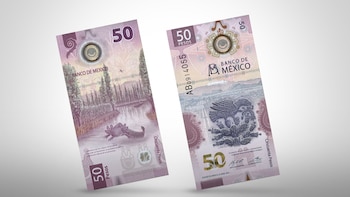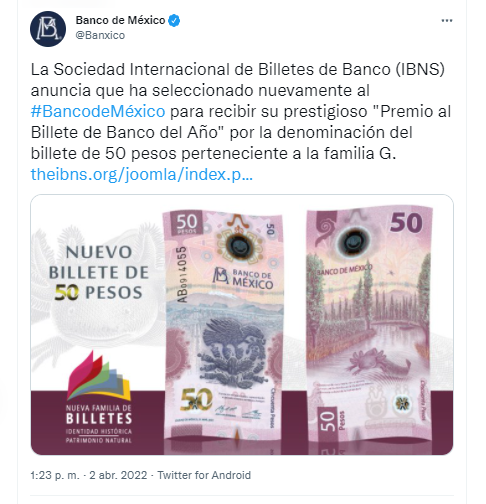
The 50-peso note belonging to the G family was awarded by the International Banknote Society (IBNS) for being the Best Banknote of the Year 2021.
The competition involved more than 100 banknotes that were released last year, but only 20 were selected for nominations due to their innovation in design.
According to IBNS, the vote was almost even between two participating banknotes: the 50-peso bill from Mexico (which shows the axolotl in its reverse part) and the 200-dobra banknote from Sao Tome and Principe, which includes in its design the leader of the slaves, Rei Amador, butterflies and flowers.
Meanwhile, in third place there was a tie between the 10,000-colones note of Costa Rica, which shows the abolition of the leader of the army, rainforest and flora, and the Bank of England's 50-pound banknote (which shows Queen Elizabeth II along with Alan Turing and her iconic computer to decipher) codes of war).

The other main places were occupied by: the 20 Lei banknote from Romania (showing the country's heroine with saffron, Ecaterina Teodoroiu), the 50 pound note from the Royal Bank of Scotland (which shows the social reformer Flora Stevenson), the 20 Yuan from China (with the theme of the 2022 Winter Olympics) and the Cook Islands $3 (with nature design and a whale).
It should be noted that Banco de México was the entity responsible for printing and issuing the award-winning 50-peso banknote and it was first presented in 2018. Its production took place in the new printing complex located in Jalisco, which began operating before the COVID-19 pandemic began.
IBNS pointed out that among the best features of this banknote is security, since there was a transition to a polymer substrate, which was implemented in September 2002 on the 50-peso banknote showing María Morelos and Pavón. According to the Banco de México, the polymer substrate is beneficial because it is cheaper, less harmful to the environment and harder to counterfeit.

Other elements of its security are: touch-sensitive reliefs, growing folio, linear backgrounds, fluorescence, transparent window, element that changes color (in this case the wing of the butterfly) and multicolored denomination.
The 50 peso banknote of the Banco de México has a dimension of 125 by 65 millimeters. The obverse shows Ancient Mexico accompanied by the monolith known as “Teocalli of the Sacred War”, which consists of an eagle perched on a prickly pear, belonging to the Mexican culture. In the background, we can see the city of Tenochtitlan based on a mural by Diego Rivera that is located in the National Palace, called “La gran Tenochtitlan (seen from the Tlatelolco Market)”.
The design on the reverse is inspired by the ecosystems of rivers, lakes and waterways of Xochimilco, which features the axolotl, one of the country's most emblematic amphibians, which is in danger of extinction.
Other banknotes competing in this contest were: 50 United Arab Emirates Dirhams, 5 Libyan Linares, 100 Soles from Peru and 5,000 Som from Uzbekistan.
KEEP READING:
Últimas Noticias
Debanhi Escobar: they secured the motel where she was found lifeless in a cistern
Members of the Specialized Prosecutor's Office in Nuevo León secured the Nueva Castilla Motel as part of the investigations into the case

The oldest person in the world died at the age of 119
Kane Tanaka lived in Japan. She was born six months earlier than George Orwell, the same year that the Wright brothers first flew, and Marie Curie became the first woman to win a Nobel Prize

Macabre find in CDMX: they left a body bagged and tied in a taxi
The body was left in the back seats of the car. It was covered with black bags and tied with industrial tape
The eagles of America will face Manchester City in a duel of legends. Here are the details
The top Mexican football champion will play a match with Pep Guardiola's squad in the Lone Star Cup

Why is it good to bring dogs out to know the world when they are puppies
A so-called protection against the spread of diseases threatens the integral development of dogs




